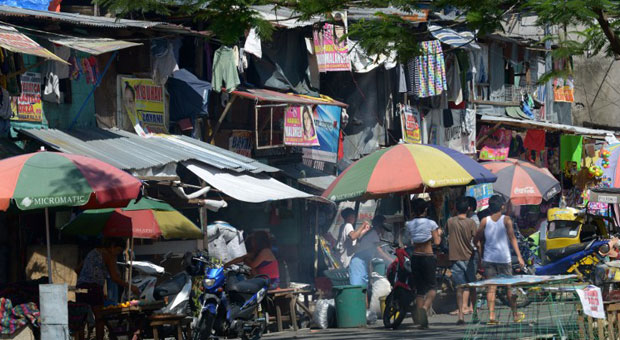COVID-19 makes Duterte’s 2022 poverty-reduction goal unachievable

The revert to stringent, blanket lockdown measures, whenever there was a surge in COVID-19 infections, had pushed more people to temporary poverty and job losses. AFP FILE PHOTO
MANILA, Philippines—The prolonged COVID-19 pandemic has reversed prior gains in poverty reduction, such that the Duterte administration will fail to achieve its 14-percent poverty incidence goal when the President steps down next year.
Economic managers on Thursday also expressed concern about the limited effectiveness of distance learning, hence they pushed for the long-delayed pilot of face-to-face classes in low-risk areas when the threat posed by the more infectious Delta strain of COVID-19 subsides.
Socioeconomic Planning Secretary Karl Kendrick Chua told senators that the past one year when students were unable to attend classes in-person was estimated to result in P11-trillion worth of productivity losses during a 40-year period covering a person’s usual working life span.
Chua explained that this estimate of the state planning agency National Economic and Development Authority (Neda) covered the impact on the economy of all students who did not get proper face-to-face learning amid the pandemic.
Earlier estimates of the Manila-based Asian Development Bank (ADB) showed that the economy likely incurred P1.9 trillion in losses for each year that schools were closed.
The Washington-based World Bank last May urged allowing in-person classes among pupils whose parents consented, as distance learning had “limited effectiveness” and possibly increased learning poverty – the share of 10-year-olds who cannot read nor understand a simple story – in 2020. In 2019, the pre-pandemic learning poverty in the country was already a high 69.5 percent.
Finance Secretary Carlos Dominguez III said they already proposed to vaccinate all teachers as well as administrative and support staff in schools, alongside weekly testing and contact tracing among students and school personnel to safely reopen face-to-face classes.
On top of the long-term scarring effect on the education sector, Chua disclosed that the poverty rate was estimated to have risen to 18.3 percent last year, equivalent to about 20 million poor Filipinos, from the record-low 16.7 percent or 17.7 million individuals living in poverty in 2018.
Chua said poverty incidence was expected to “gradually fall” to 17.9 percent this year or 19 million Filipinos, and then to 15.7 percent next year or 17 million people.
“The 14-percent target would have been achieved without COVID-19,” Chua said.
However, Chua said the revert to stringent, blanket lockdown measures whenever there was a surge in COVID-19 infections had pushed more people to temporary poverty and job losses.
As such, Chua said he supported the shift to granular lockdowns to limit restrictions in high-risk areas.
For more news about the novel coronavirus click here.
What you need to know about Coronavirus.
For more information on COVID-19, call the DOH Hotline: (02) 86517800 local 1149/1150.
The Inquirer Foundation supports our healthcare frontliners and is still accepting cash donations to be deposited at Banco de Oro (BDO) current account #007960018860 or donate through PayMaya using this link.
